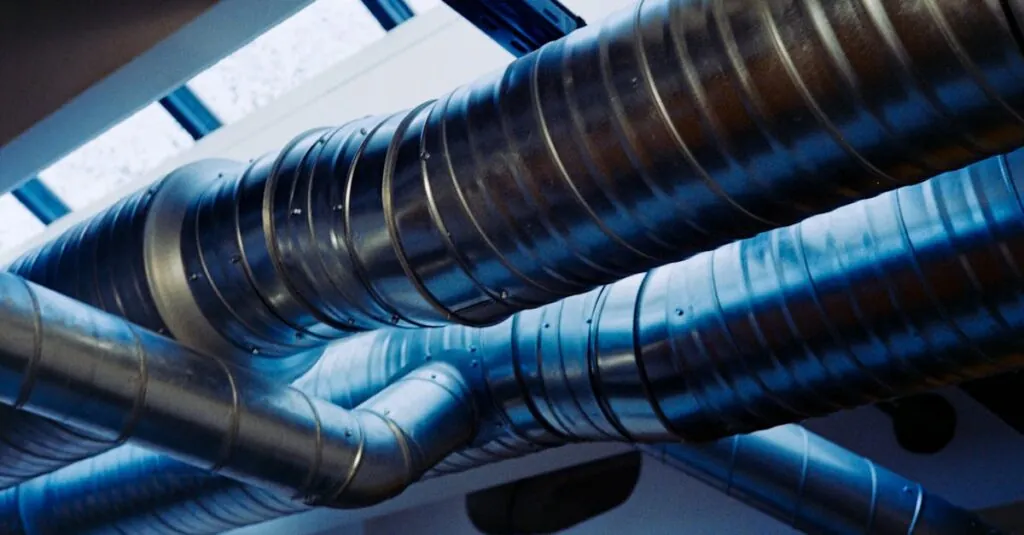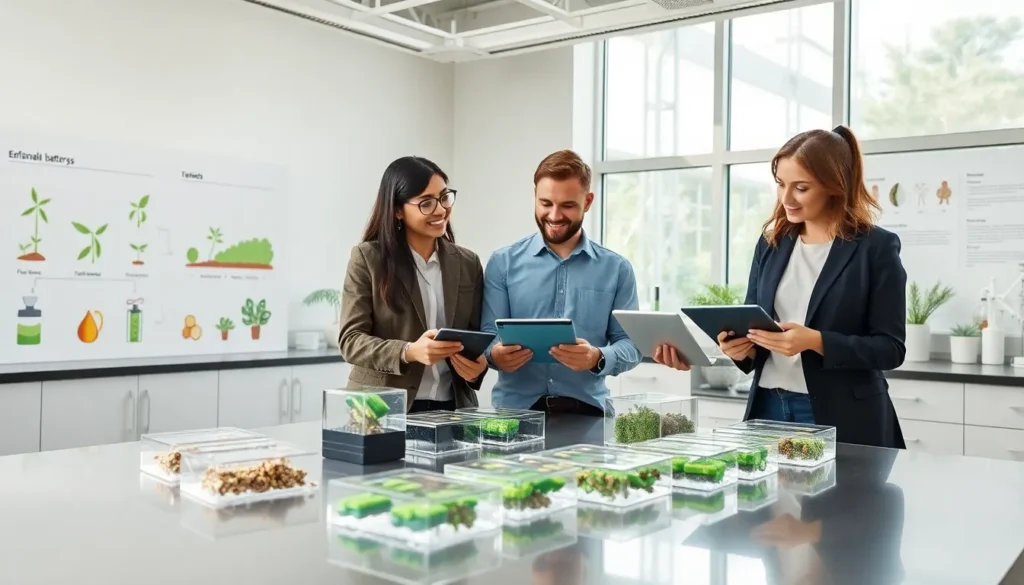Table of Contents
ToggleIn a world where building a home often means leaving a hefty carbon footprint, eco-friendly construction tech is like the superhero we didn’t know we needed. Imagine using materials that not only stand the test of time but also give Mother Earth a high-five. From solar panels that soak up the sun like a beachgoer to bricks made from recycled materials, the future of construction is looking greener than ever.
Overview Of Eco-Friendly Construction Tech
Eco-friendly construction technology evolves to address the environmental challenges associated with traditional building practices. This technology emphasizes the use of sustainable materials that reduce environmental footprints while enhancing efficiency. Examples of such materials include bamboo, which grows rapidly and absorbs more carbon dioxide than many traditional timber types, making it an ideal choice for building.
Solar panels play a significant role in eco-friendly construction. They harness renewable energy, providing a clean power source that decreases reliance on fossil fuels. Green roofs, another innovative feature, improve energy efficiency as they provide insulation and promote biodiversity.
Recycled materials, such as reclaimed wood and repurposed bricks, minimize waste by reusing existing resources in new construction projects. Utilizing these materials not only conserves natural resources but also often results in unique aesthetic choices for architects and builders alike.
Smart home technology enhances energy efficiency with features like programmable thermostats and energy monitoring systems. These tools allow homeowners to optimize energy use based on real-time data and personal preferences. Incorporating energy-efficient appliances also contributes to lower energy consumption.
Finally, sustainable construction tech extends to building design through techniques such as passive solar design. This approach maximizes sunlight for heating and natural light while minimizing the need for artificial lighting. Tools like building information modeling (BIM) help in planning by enabling precise assessments of energy usage, material quantities, and overall environmental impact.
Benefits Of Eco-Friendly Construction
Eco-friendly construction offers numerous advantages that range from reducing environmental harm to providing economic benefits.
Environmental Impact
Eco-friendly construction significantly reduces carbon emissions. Sustainable materials absorb carbon dioxide, contributing to cleaner air. Using renewable resources like bamboo and reclaimed wood aids in minimizing habitat destruction. The implementation of solar panels harnesses clean energy, reducing reliance on fossil fuels. Additionally, green roofs enhance urban biodiversity and improve insulation, further decreasing energy consumption. Incorporating energy-efficient systems decreases overall resource use. According to the U.S. Green Building Council, green buildings generate up to 30 percent less carbon dioxide than traditional constructions.
Economic Advantages
Eco-friendly construction results in long-term cost savings. Energy-efficient buildings reduce utility bills by up to 30 percent, allowing for reduced operational costs. Utilizing recycled materials often lowers construction expenses while minimizing waste. Government incentives for sustainable building practices reduce initial investment costs. Increased property values and marketability benefit eco-friendly homes, attracting environmentally conscious buyers. Implementing smart technology optimizes energy consumption, further enhancing savings. Research shows that green buildings maintain a 7.5 percent increase in asset value compared to traditional buildings.
Types Of Eco-Friendly Construction Technologies
Eco-friendly construction technologies encompass various innovative approaches aimed at reducing environmental impact. These methods utilize sustainable materials and energy-efficient systems, contributing to a greener future in building design.
Sustainable Materials
Bamboo stands out as a prime example of a sustainable material. It absorbs carbon dioxide and grows rapidly, making it an ideal choice for construction. Recycled bricks have also gained popularity, as they minimize waste by repurposing existing materials. Another option includes reclaimed wood, which reduces deforestation and fosters a circular economy. Even recycled steel offers durability while decreasing the need for new raw resources. Utilizing these materials significantly decreases the carbon footprint of building projects and promotes eco-conscious practices within the industry.
Energy-Efficient Systems
Solar panels represent a cornerstone of energy-efficient systems in eco-friendly construction. They harness renewable energy, significantly lowering reliance on fossil fuels. Programmable thermostats contribute to enhanced energy management, helping residents control heating and cooling efficiently. Insulation systems made from sustainable materials also improve energy performance by preventing heat loss. Green roofs provide natural insulation while promoting biodiversity. These energy-efficient technologies together create a framework that supports sustainable living and reduces overall environmental impact.
Innovations In Eco-Friendly Construction
Innovations in eco-friendly construction focus on technological advancements that promote sustainability and resource efficiency.
Modular Construction
Modular construction offers an efficient alternative to traditional building methods. This approach uses prefabricated sections, minimizing waste and speeding up the construction process. Buildings can reach up to 50 percent faster completion compared to conventional methods. Reducing on-site construction time lowers costs significantly, leading to savings of 10 to 20 percent. Modular structures also support flexibility and scalability, adapting to changing needs without extensive renovation. As a result, this construction method aligns with sustainable practices and reduces carbon footprints, ensuring a smaller environmental impact.
Smart Building Technologies
Smart building technologies enhance energy efficiency and contribute to a sustainable future. These systems integrate advanced automation features, optimizing energy use based on occupancy and environmental conditions. For instance, programmable thermostats adjust heating and cooling for maximum efficiency, potentially lowering energy bills by up to 30 percent. Smart lighting solutions combine with natural light, reducing reliance on electricity during the day. Additionally, sensors monitor air quality, allowing for timely adjustments that improve indoor environments. This fusion of technology and construction fosters long-term sustainability, making buildings greener and more responsive to user needs.
Challenges In Implementing Eco-Friendly Construction Tech
Implementing eco-friendly construction technology presents several challenges. These hurdles require attention for widespread adoption and effectiveness.
Cost Considerations
High initial costs often deter builders from adopting eco-friendly technologies. Upfront investments for sustainable materials and advanced systems may exceed traditional building expenses. For instance, while solar panels can reduce energy bills significantly in the long term, the initial installation can seem daunting. Many construction projects aim for budget adherence, making the transition to green solutions challenging. Financial incentives, however, can alleviate some of these burdens by offsetting costs and encouraging investment in sustainability. Builders might discover that, over time, the return on investment for eco-friendly technologies justifies the initial outlay.
Regulatory Hurdles
Regulatory challenges arise from varying building codes and standards across regions. Many jurisdictions lack clear guidelines on eco-friendly construction practices, leading to confusion and inconsistency. Compliance with local regulations can impede the adoption of innovative technologies like modular construction or smart building systems. Some builders may face lengthy approval processes, which slow down projects and increase costs. Solutions exist, such as advocating for standardized regulations that promote sustainability without sacrificing safety. Policymakers can create an environment that supports eco-friendly innovations if they prioritize clarity and uniformity in building policies.
Conclusion
Eco-friendly construction technology stands at the forefront of a transformative shift in the building industry. By embracing sustainable materials and innovative energy-efficient systems, it paves the way for a greener future. The integration of smart technologies not only enhances energy efficiency but also elevates the overall quality of living spaces.
Despite the challenges of high initial costs and regulatory hurdles, the long-term benefits of eco-friendly construction are undeniable. As awareness grows and financial incentives become more accessible, the path toward sustainable building practices will likely become clearer. This evolution in construction technology not only addresses environmental concerns but also fosters economic growth and improved living conditions for future generations.




